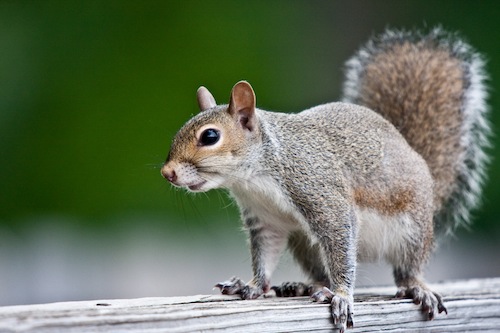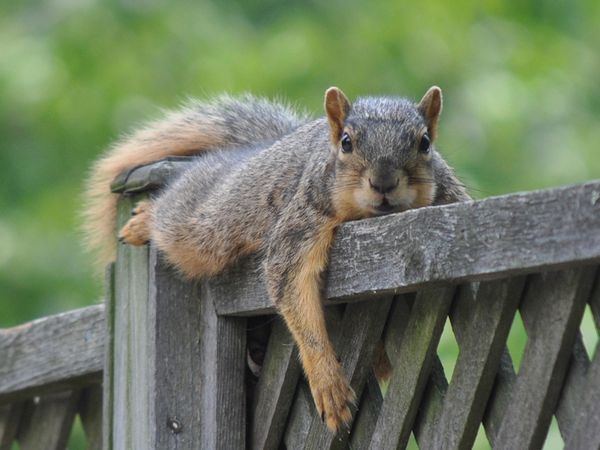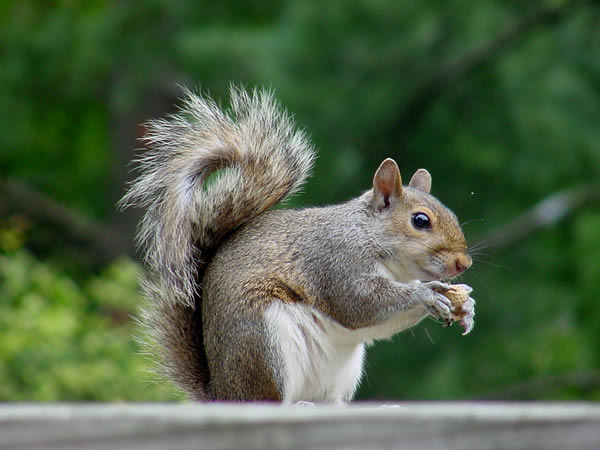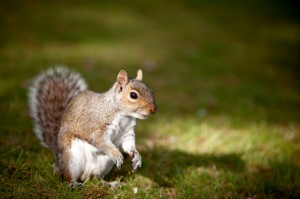
The Fox squirrel is the largest species of tree squirrels and the resident squirrel of central Texas. Most of these socially accepted day time rats owe their existence to humans.
We supply their necessities of life: food and shelter, allowing them to prosper from the urban setting. Even its comical attempts at accessing bird feeders, high reproduction rate, and aggressive determination to utilize attics for nesting makes the Fox squirrel a very common wildlife conflict for homeowners.
Physical Abilities
 Squirrels are impressive jumpers, easily spanning fifteen feet in horizontal leaps and free-falling twenty feet or more without injury. The ability to climb any textured vertical surfaces including the inside of downspouts of rain gutters to access roofs. The squirrel is able to chew thru various materials from lead to composition roofing to access the attic. See photos of squirrel damage in the photo gallery.
Squirrels are impressive jumpers, easily spanning fifteen feet in horizontal leaps and free-falling twenty feet or more without injury. The ability to climb any textured vertical surfaces including the inside of downspouts of rain gutters to access roofs. The squirrel is able to chew thru various materials from lead to composition roofing to access the attic. See photos of squirrel damage in the photo gallery.
Biology & Habits
 There are two breeding seasons, one peaking in December and the other in June. Breeding begins at one year of age and a gestation period of 42 to 45 days. Average litter size is 3 to 4. At birth they are hairless, blind, and their ears are closed. Newborns weigh about ½ ounce at birth and 3 to 5 ounces at 5 weeks. Young begin to explore outside the nest about the time they are weaned at 10 to 12 weeks. Squirrels are almost always busy preparing for the winter. A squirrel’s diet will change thru the year, in the warmer months their diet consist of fruits, berries and succulent plant materials as well as some nuts . Nuts such as acorns and pecans are most often cached for winter. In early spring they prefer tree buds. The urbanized squirrel’s diet may not fluctuate as much due to the abundance of bird feeders in neighborhoods. Male squirrels are very territorial and readily mark their area.
There are two breeding seasons, one peaking in December and the other in June. Breeding begins at one year of age and a gestation period of 42 to 45 days. Average litter size is 3 to 4. At birth they are hairless, blind, and their ears are closed. Newborns weigh about ½ ounce at birth and 3 to 5 ounces at 5 weeks. Young begin to explore outside the nest about the time they are weaned at 10 to 12 weeks. Squirrels are almost always busy preparing for the winter. A squirrel’s diet will change thru the year, in the warmer months their diet consist of fruits, berries and succulent plant materials as well as some nuts . Nuts such as acorns and pecans are most often cached for winter. In early spring they prefer tree buds. The urbanized squirrel’s diet may not fluctuate as much due to the abundance of bird feeders in neighborhoods. Male squirrels are very territorial and readily mark their area.
Management
Squirrels are very persist in nature, once established, in the attic, squirrels must be trapped and removed to lessen the chance of future damage caused by the animal trying to re-enter the structure. Squirrels that are denied their previously used access will often make a new entry point. Allowing squirrels to live and raise young in your attic can be costly. Austin’s Wildlife Removal Service’s identifies all points of entries and monitors the entries after the squirrel has been removed to ensure complete removal of squirrels from attic before animal proofing. AWRS uses a 26 gauged paint grip sheet at all roof intersections, and all roof and gable vents are proofed with a 23 gauged galvanized, woven hardware cloth. This prevents animal entry, while allowing air flow thru vents.
Diseases
 Squirrels in general are not considered a significant public health concern, as with all animals squirrels do carry parasites such as fleas, along with urine and dropping can be a vector of diseases, such as:
Squirrels in general are not considered a significant public health concern, as with all animals squirrels do carry parasites such as fleas, along with urine and dropping can be a vector of diseases, such as:
- The Plague
- Leptospirosis
- Salmonella
- Squirrel Pox
Damage
Squirrels damage array of items from landscaping by chewing the bark from tree trunks and branches as well as the buds of new growth. Damage can occur when squirrels chew their way in attic thru wood, aluminum siding, light gauged screening covering roof and gable vents. An in the attic squirrels can damage air conditioning ducts to electrical and alarm wiring all the while depositing their dropping and urine.
